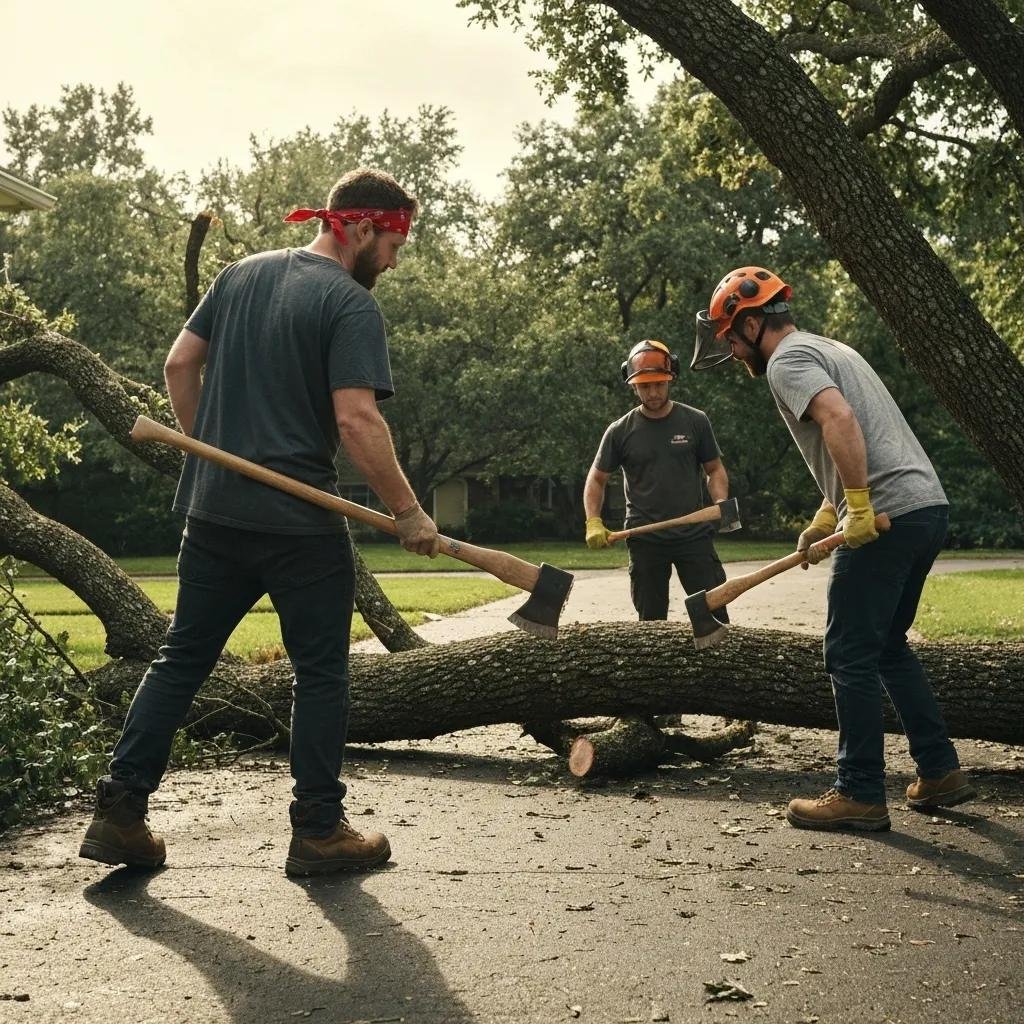Optimized Port Orange Tree Removal: Costs, Emergencies, and Success
Each year, property owners in Port Orange face tree hazards that require professional attention for safety and to meet local regulations. In this guide, you’ll explore real-life Port Orange Tree Removal Case Studies, detailed cost breakdowns, emergency response procedures, challenges in complex projects, permit requirements, successful outcomes, the importance of certified arborists, and essential preparation steps for homeowners. By diving into these topics, you’ll gain a clear understanding of budgeting, legal compliance, and choosing the right service provider—empowering you to find expert solutions at Treeserviceportorange.com.
What Are the Typical Costs for Tree Removal in Port Orange?
Typical tree removal expenses in Port Orange encompass labor, equipment, and safety measures to ensure thorough service. Understanding the cost structure helps property owners plan their budgets and avoid unexpected charges.
How Does Tree Size and Complexity Affect Removal Costs?
The cost of tree removal is influenced by the tree’s size, species, and the difficulty of the site. Larger trees and those in challenging locations demand more resources. For instance, a 50-foot oak near power lines requires specialized rigging and a larger crew, while a 20-foot palm in an open yard needs minimal equipment. This relationship between size and complexity directly impacts project timelines and safety planning, guiding homeowners toward accurate estimates.
Tree Dimensions and Site Complexity
| Tree Size Category | Estimated Cost (USD) | Equipment Required |
|---|---|---|
| Small (up to 20 ft) | 150 – 450 | Standard chainsaws, 2-person crew |
| Medium (21–40 ft) | 450 – 900 | Aerial lift, rigging, 3-person crew |
| Large (41–60 ft) | 900 – 2,000 | Crane or bucket truck, 4+ crew |
| Very Large (>60 ft) | 2,000 – 3,500+ | Crane, grapple truck, specialized rigging |
These cost ranges illustrate how height and accessibility challenges affect pricing. Higher complexity necessitates additional safety precautions and machinery, setting the stage for emergency removal scenarios.
What Are the Average Prices for Emergency and Complex Tree Removal?
Emergency and complex removals often come with higher costs due to the need for rapid response and specialized equipment. Emergency tree removal rates in Port Orange typically start around $600 and can go over $1,500, while crane-assisted jobs can range from $1,200 to $4,000, depending on the tree’s size and proximity to structures. Swift action and risk mitigation explain the increased costs for urgent or technically demanding projects.
How Do Stump Grinding and Tree Trimming Services Impact Overall Costs?
Adding stump grinding or trimming to a tree removal service can improve site clearance and long-term aesthetics but will incur additional fees. Integrating stump grinding typically adds $100–$400, while trimming nearby limbs before removal might add $150–$350. Bundling services can sometimes lead to discounts and help prepare your property more comprehensively, allowing homeowners to balance complete care with their budget. Anticipating these add-ons ensures transparent pricing and a polished finish.
Moving from cost considerations, the need for urgent interventions leads to emergency removal processes that prioritize safety and speed.
How Do Emergency Tree Removal Services Work in Port Orange?

Emergency tree removal addresses immediate hazards through rapid assessment, specialized crews, and 24/7 availability. This approach minimizes property damage and public risk following storms or sudden tree failures.
What Situations Require Emergency Tree Removal?
- Fallen trees blocking driveways or roads.
- Branches threatening power lines or structures after severe weather.
- Diseased trees showing sudden signs of instability.
- Hanging branches or cracked trunks posing an immediate collapse risk.
These critical situations demand swift action to restore safety and clear access, prompting homeowners to contact certified experts without delay.
How Quickly Can Emergency Tree Removal Be Scheduled and Completed?
Emergency crews typically respond within 2–6 hours of being notified, though during peak storm periods, same-day scheduling might be extended. Rapid deployment of equipment—including chainsaws, aerial lifts, and debris trucks—allows for project completion within a few hours for single-tree emergencies. Faster service reduces liability and allows property recovery to proceed with minimal disruption.
What Safety Measures Are Used During Emergency Tree Removal?
- Site Assessment – Inspecting failure points and establishing clear exclusion zones.
- Rigging Systems – Attaching ropes or slings to control the descent of limbs.
- Protective Barriers – Setting up barricades to safeguard pedestrians and vehicles.
- Personal Protective Equipment – Equipping crews with helmets, eye protection, and cut-resistant gear.
These safety measures build confidence and ensure that emergency removal not only resolves hazards but also protects surrounding property. With secure protocols in place, complex projects can then proceed under controlled conditions.
What Are the Key Challenges in Complex Tree Removal Projects?

Complex removals involve high elevations, confined spaces, or legal restrictions that require advanced planning, teamwork, and specialized machinery to complete safely and efficiently.
How Do Arborists Handle Large or Hazardous Trees Near Structures?
Certified arborists use precise rigging and sectional dismantling techniques to remove trees situated near homes or utility lines. By cutting branches into manageable sections and lowering them using rope-and-pulley systems, they prevent accidental drops. This method preserves the structural integrity of adjacent buildings while eliminating risk—an essential strategy for safeguarding property and personnel.
What Equipment Is Used for Safe and Efficient Complex Tree Removal?
| Equipment | Purpose | Benefit |
|---|---|---|
| Crane | Lifting and lowering heavy sections | Minimizes overhead risks |
| Grapple Truck | Securing large logs for transport | Speeds up debris removal |
| Aerial Lift | Providing access to high branches | Enhances precision in tight spots |
| Rigging Gear | Controlling limb descent | Ensures safe, controlled lowering |
How Are Local Permits and Regulations Managed During Complex Removals?
Port Orange and Volusia County have permitting requirements based on tree size, species protection, and zoning regulations. Arborists manage permit applications, provide necessary site plans, and schedule inspections to obtain approval before commencing work. This proactive compliance approach prevents costly violations and ensures projects align with municipal standards, guaranteeing lawful and smooth tree removal.
Navigating permit requirements leads us directly into understanding the formal permit processes in the region.
How Do Tree Removal Permits Work in Port Orange and Volusia County?
Tree removal permitting in Port Orange and Volusia County is designed to protect the environment and manage urban tree canopies by establishing clear guidelines and application procedures.
When Is a Tree Removal Permit Required in Port Orange?
- Trees taller than 15 ft.
- Involvement of protected species (e.g., live oaks).
- Removal impacting conservation areas or coastal zones.
These criteria help safeguard local ecosystems and define when property owners must contact authorities before proceeding with removal.
How Can Property Owners Navigate the Permit Application Process?
- Consult with an Arborist – Identify protected species and assess the necessity of removal.
- Prepare a Site Plan – Document the tree’s location, size, and surrounding structures.
- Submit the Permit Application – File the necessary forms with the City Planning Division and pay any required fees.
- Schedule an Inspection – Arrange for a city arborist to inspect the site and verify compliance before work begins.
Volusia Tree Permitting: Key Information
Volusia County’s Tree Preservation Ordinance details specific requirements for tree removal permits, distinguishing between residential and commercial properties. Key regulations include mandatory tree surveys for residential removals and the requirement for replacement trees to be Florida native species, both effective January 1, 2021. Failure to comply with these regulations can result in significant fines and penalties.
This citation directly supports the article’s section on tree removal permits in Port Orange and Volusia County, outlining when permits are necessary, specific rules like tree surveys and native species replacement, and potential penalties for non-compliance.
What Are the Consequences of Removing Trees Without Permits?
- Fines up to $1,000 per tree.
- Mandatory requirements to replace trees.
- Stop-work orders and legal enforcement actions.
Understanding these risks highlights the importance of proper permitting and professional guidance, ensuring your project proceeds without penalties and adheres to community standards.
Comprehending permit regulations paves the way for examining real success stories that bring these processes and methodologies to life.
What Do Real Case Studies Reveal About Tree Removal Success in Port Orange?
Case studies showcase precise execution, adherence to regulations, and exceptional results that property owners value when facing challenging tree situations.
How Was a Large Oak Tree Safely Removed Using Crane Assistance?
In one project, a 65-ft oak tree situated near a residence posed a threat to the roof. Certified arborists conducted a site assessment, secured the necessary permits, and utilized a 30-ton crane to safely lift and lower trunk sections. This method prevented damage to nearby structures and completed the full removal within a single day, leaving the homeowner with a hazard-free property.
What Was the Process for Storm Damage Cleanup in Volusia County?
Following Hurricane Ian, a client dealt with numerous downed limbs. Emergency crews arrived within hours, cleared roadways, sectioned uprooted trees, and ground stumps to restore access. This rapid response minimized safety risks and expedited debris removal, demonstrating the value of round-the-clock readiness and robust equipment.
How Was a Palm Tree Removed in a Tight Residential Space?
A mature Sabal palm tree located in a narrow driveway required careful sectional removal. Arborists climbed the crown, cut fronds and trunk sections, and lowered each piece using ropes to avoid contact with fences and vehicles. This meticulous technique preserved surrounding structures and highlighted skillful planning in confined areas.
What Are the Outcomes of Commercial Lot Clearing Projects?
For a commercial development in Port Orange, crews executed large-scale lot clearing, removing over 200 trees, grinding stumps, and preparing the site for construction. The integrated approach—combining feller-bunchers, grapple trucks, and skid steers—completed the project within the designated 10-day timeframe, demonstrating efficiency and compliance with environmental regulations.
These success stories emphasize why entrusting work to certified arborists leads to superior safety, compliance, and client satisfaction.
Why Choose Certified Arborists for Tree Removal in Port Orange?
Certified arborists combine formal education, practical experience, and industry credentials to provide dependable tree removal services that prioritize safety, tree health, and local standards.
What Qualifications and Experience Do Local Arborists Have?
- ISA Certification – Demonstrating expertise in tree biology and risk assessment.
- State Licenses – Authorizing the use of heavy equipment and treatments.
- Safety Training – Including OSHA standards and aerial rescue protocols.
Compliance with ANSI Z133.1 - 2006 Safety Standard in Tree Care
Research indicates that arborists face significantly higher occupational fatality rates compared to other U.S. workers. A study found that tree care companies with accreditation and certified arborists on staff generally exhibit higher compliance with industry safety standards, such as ANSI Z133.1, although overall adherence to basic safety practices like personal protective equipment and chainsaw safety can still be improved across the industry.
This research underscores the critical importance of certified arborists and adherence to established safety standards, directly supporting the article’s emphasis on choosing certified arborists for safe and compliant tree removal operations.
How Do Arborists Ensure Safety and Property Protection?
- Risk Evaluation – Identifying potential hazards and planning mitigation strategies.
- Rigorous Protocols – Employing fall-restraints, traffic control, and exclusion zones.
- Equipment Inspection – Maintaining machinery to prevent operational failures.
- Post-Removal Inspection – Verifying site stability and ensuring all debris is cleared.
This comprehensive approach builds client trust and minimizes liabilities.
What Do Customers Say About Their Tree Removal Experiences?
- Timely Communication – Providing transparent updates from the initial estimate to project completion.
- Clean Worksite – Thorough debris removal and property restoration.
- Professional Conduct – Courteous, uniformed crews maintaining respectful boundaries.
Client testimonials validate the reliability and high standards that distinguish certified arborists in Port Orange.
With trusted expertise secured, homeowners can now prepare for their own tree removal projects with confidence.
How Can Property Owners Prepare for Tree Removal Projects?
Proper preparation streamlines projects, prevents unexpected issues, and ensures efficient, safe removals that meet homeowner expectations.
What Are the Signs a Tree Needs Removal or Trimming?
- Cracks or hollows in the trunk.
- Leaning growth towards structures.
- Dead or decaying branches.
- Root damage or soil heaving.
Recognizing these early indicators allows property owners to address hazards before they escalate into emergencies.
How to Schedule and Get Accurate Tree Removal Estimates?
- Contact Certified Arborists – Provide tree dimensions, photos, and details about site access.
- Request Written Estimates – Compare the scope of work, equipment used, and safety measures proposed.
- Verify Insurance – Confirm liability and workers’ compensation coverage.
- Agree on a Timeline – Coordinate availability with weather conditions and permit processing times.
These steps lead to clear expectations and fair pricing.
What Should Property Owners Expect During the Tree Removal Process?
- Safety Setup – The crew establishing exclusion zones and protective barriers.
- Sectional Dismantling – Removing branches and trunk sections in defined pieces.
- Debris Management – Loading and hauling away cut materials.
- Site Cleanup – Raking, stump grinding, and a final inspection of the area.
Understanding each phase prepares homeowners for minimal disruption and optimal results.
How to Maintain Your Property After Tree Removal and Stump Grinding?
- Soil Replenishment – Adding mulch or topsoil to compacted areas.
- Landscape Restoration – Planting new vegetation or grass seed.
- Debris Monitoring – Removing any stray wood chips or root fragments.
- Routine Inspection – Checking for new growth or pest infestations.
These maintenance tasks ensure lasting aesthetics and healthy regeneration of your outdoor space.
By following these preparation guidelines, property owners can achieve smooth, effective tree removal experiences that maximize safety and satisfaction.
In Port Orange, successful tree removal hinges on combining accurate cost assessments, rapid emergency response, advanced equipment, regulatory compliance, practical expertise, certified arboreal professionals, and homeowner preparedness—all demonstrated in these case studies and best practices.
